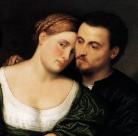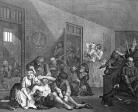Robert Browning's Porphyria's Lover- Tyri Barker
Created by Tyri Barker on Sun, 10/24/2021 - 19:45
Part of Group:
Finding the details as to what events may have lead to the writing of "Porphyria's Lover". Robert Browning wrote a host of dramatic monologue that made him very famous. In the 19th Century women were not considered equal to men, the traditions of victorian women saw them only as housewives and cooks.The poem is spoken by a poetic speaker which helps offer deeper meaning of the poem. Robert Browning offers a poem that shows how woman in the victorian era could be taken advantage of.
Timeline
Chronological table
| Date | Event | Created by | Associated Places | |
|---|---|---|---|---|
| 1836 |
Porphyria's LoverIn Porphyria's Lover, we see a host of things. Madness, Dramatic Monulgue, and Seperate Spheres. This poem was told by the poetic speaker and not the author. What seems to be a lust over a women quickly becomes more than that. The poetic speaker begins to objectify Porphyria as he describes the details of her body. The poetic speaker developes an obsession with Porphyria. This obsession would soom become deadly and seems as if it is what the poetic speaker wanted all along. |
Tyri Barker | ||
| 2006 |
Madness in the 19th CenturyDuring this time period there was a rise in the number of women admitted into insane asylums. Women were placed in mental instutions for not following the tradions of a victorian women. Women had minimal rights during this time period. Women would be diagnosed insane for reasons like, religious excitement, epilepsy,and suppressed menustruation. These labeled women as insane and this was heavenly influenced by social attitudes toward women. In "Porphyria's Lover" we see the insanity but we see it in the male and not the the woman. Pouba, Katherine, and Ashley Tianen. “Lunacy in the 19th Century: Women’s Admission to Asylums in United States of America.” Minds.wisconsin.edu, 1 May 2006, minds.wisconsin.edu/handle/1793/6687. |
Tyri Barker | ||
| 2012 |
Dramatic MonologueDuring this time Dramatic Monologue offered a deeper connection between the speaker of the poem and the reader of the poem. Dramatic Monologue is a single person who is not the author who speaks throughout the whole poem. Thi sperson usally adresses and interacts with one or more people throughout the poem. The purpose of this is to reveal to the reader in a way that makes them more curious in the poem. This is what's used in "Porphyria's Lover", the author leaves room for the reader to ask several questions. Avery_Sharp. “Robert Browning and the Dramatic Monologue | Armstrong Browning Library & Museum.” Baylor University, 1 Aug. 2012, blogs.baylor.edu/armstrongbrowning/2012/08/01/robert-browning-and-the-dramatic-monologue. |
Tyri Barker | ||
| 2014 |
Separate SpheresIn the 19th century the husband and wife would only come together at breakfast and dinner. In this age women were considered to be weaker than men, however they were considered morally superior to men. They were best suited for domestic duties like cooking, cleaning and other house chores. They were preparing the next genration to carry out this way of life. Because woman had such great influnce at home, it helped the argument when deciding should they have the right to vote. Porphyria's Lover shows the weakness that is seen in the woman compared to the man. The poetic speaker showed how easily he could take advantage of Woman. “British Library.” The British Library, 2014, www.bl.uk/romantics-and-victorians/articles/gender-roles-in-the-19th-cen.... |
Tyri Barker | ||
| 2018 |
Agnes MarshallAgnes Marshall is responsible for teaching an entire generation of victorian women how to cook. She would teach woman how to use different technologies in the kitchen long before there were modern and household appliences. she is considered to be an early example of a businesswoman. These traditions and practices of the Victorian era are shown in "Porphyria's Lover" as she is just a housewife . Blakemore, Erin. “Meet the Martha Stewart of the Victorian Era.” HISTORY, 23 Aug. 2018, www.history.com/news/meet-the-martha-stewart-of-the-victorian-era. |
Tyri Barker |





